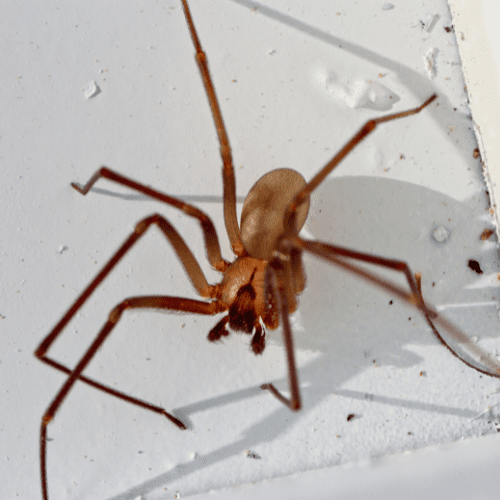Brown Recluse Spider
Introduction to
The brown recluse spider, scientifically known as Loxosceles reclusa, is one of the most feared spiders in North America due to its potentially dangerous bite. Recognizable by its violin-shaped marking, this spider prefers dark, secluded areas and often resides in homes, posing a risk to unsuspecting residents. Understanding how to identify, prevent, and professionally manage brown recluse spiders is crucial for maintaining a safe living environment. This article explores the recognition, biology, habits, prevention, and professional handling of brown recluse spiders.
Recognition
The brown recluse spider is small, typically ranging from 6 to 20 millimeters in body length. Its most distinctive feature is a dark, violin-shaped marking on its dorsum, with the neck of the violin pointing towards the rear. The spider’s coloration is generally a uniform brown, though it can vary slightly. Unlike many other spiders, the brown recluse has only six eyes arranged in pairs, rather than the usual eight. Its legs are long and slender, often covered in fine hairs. These spiders build irregular webs, usually in undisturbed, dark areas like closets, basements, and attics.
Biology
Brown recluse spiders are nocturnal hunters, primarily feeding on small insects and other arthropods. They do not use their webs to catch prey but instead rely on their speed and venom to subdue their victims. The female brown recluse can lay eggs multiple times a year, with each egg sac containing up to 50 eggs. The spiders undergo several molts before reaching maturity, a process that can take up to a year. Brown recluse spiders can live for several years, making them a persistent presence once they establish themselves in a home.
Habits
Brown recluse spiders are reclusive by nature, as their name suggests. They prefer to hide in dark, undisturbed areas and are rarely seen during the day. Common hiding spots include behind furniture, inside boxes, and within cluttered storage areas. They are most active at night when they come out to hunt for food. While they are not aggressive, they will bite if they feel threatened or are accidentally pressed against the skin. Bites can result in necrotic wounds and require medical attention, making it essential to handle infestations carefully.
Prevention
Preventing a brown recluse spider infestation involves reducing clutter and sealing potential entry points. Regularly clean and declutter storage areas, basements, and attics to eliminate hiding spots. Use caulk to seal cracks and crevices around windows, doors, and foundations. Install tight-fitting screens on windows and doors to prevent spiders from entering. Keep outdoor lights turned off or use yellow bulbs to reduce attracting insects, which are a food source for spiders. Regularly inspect clothing, shoes, and bedding, especially if they have been in storage for a while.
Professional
If you suspect a brown recluse spider infestation, it is crucial to seek professional pest control services. STL Pest Control specializes in managing and eliminating brown recluse spiders using safe and effective methods. Their experienced technicians will conduct a thorough inspection to identify infested areas and implement targeted treatments to eradicate the spiders. They also offer ongoing monitoring and preventive measures to ensure your home remains spider-free. Professional intervention is essential to safely manage brown recluse spiders and minimize the risk of bites.



Our Office









